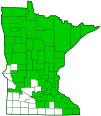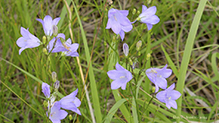intermediate bellflower
(Campanula intercedens)
Conservation • Wetland • Description • Habitat • Ecology • Use • Distribution • Taxonomy
|
|
||||||||||||||||||||||||
Description |
Intermediate bellflower is a 4″ to 20″ tall, erect, perennial forb that rises from shallow roots and a slender rhizome. The stems are slender and erect to ascending. They do not recline on adjacent plants. They are unbranched except just below the inflorescence. They may be hairless or have inconspicuous longitudinal lines of hairs. When broken, the stem exudes a milky sap. Basal leaves are, broadly egg-shaped to nearly circular, 3 ⁄16″ to ⅜″ long, and 3 ⁄16″ to 5 ⁄16″ wide. They are on slender, ¾″ to 1¼″ long leaf stalks. They are shallowly heart-shaped, rounded, or broadly angled at the base and rounded or angled to a sharp point at the tip. The upper and lower surfaces are hairless. The margins are untoothed or have a few blunt teeth. Basal leaves are often absent at flowering time. The species name, rotundifolia, refers to the shape of the basal leaves. Stem leaves are alternate and ascending or spreading. Lower stem leaves are long-stalked, narrowly elliptic to narrowly inversely egg-shaped, and 1¼″ to 2⅜″ long. The upper and lower surfaces are hairless. The margins are untoothed. The leaves become progressively smaller, narrower, and shorter stalked as they ascend the stem. Upper stem leaves are stalkless and narrowly lance-shaped to linear. The inflorescence is a nodding, usually unbranched cluster (raceme) of 3 to 8 flowers at the end of the stem. The flowers are bell-shaped and ¾″ to 1¼″ long. There are 5 green sepals (calyx), fused at their base into a 1 ⁄16″ to ⅛″ long tube, then separated into 5 linear, ⅛″ to 3 ⁄16″ long lobes. The calyx lobes are widely spreading at maturity. There are 5 light blue to blue petals (corolla), fused at their base for about half of their length into a ¼″ to ⅜″ long tube, then separated into 5 lance-shaped, ⅛″ long lobes. The lobes of the corolla are much shorter than the tube and are flared outward. The calyx and corolla are each radially symmetrical so that if bisected vertically on any plane each half would be identical. There are 5 stamens that do not protrude from the corolla tube. There is a single violet style that ends in a stigma with 3 lobes. The style protrudes from the corolla tube but is not as long as the petals. The fruit is a nearly spherical, 3-chambered capsule containing many seeds. The capsule is ⅛″ to 3 ⁄16″ long, 1 ⁄16″ to ⅛″ in diameter. |
Height |
4″ to 20″ |
Flower Color |
Blue |
Similar Species |
Habitat |
Dry to moderate moisture. Woods, meadows, cliffs, and beaches. Full or partial sun. |
Ecology |
Flowering |
June to October |
Pests and Diseases |
|
Use |
|
Distribution |
||
|
Sources 2, 3, 4, 5, 7, 24, 28, 29, 30. Campanula intercedens is currently thought to be the only naturally occurring member of the new Complex Campanula rotundifolia in Minnesota. This map includes previous records and sightings of Campanula rotundifolia in Minnesota from most sources. It does not include those that have since been identified as another species, or those that are now identified only to the level of Complex Campanula rotundifolia on iNaturalist. |
|
| 6/26/2024 | ||
Nativity |
||
Native |
||
Occurrence |
||
Common |
||
Taxonomy |
|
Kingdom |
|
Division |
Tracheophyta (Vascular Plants) |
Subdivision |
Spermatophytina (Seed Plants) |
Class |
|
Order |
Asterales (Sunflowers, Bellflowers, Fanflowers, and Allies) |
Family |
Campanulaceae (bellflower) |
Subfamily |
Campanuloideae (bellflower) |
Genus |
Campanula (bellflowers) |
Until recently, Campanula rotundifolia was considered to be a single variable species that was widely distributed and common throughout the temperate regions of the Northern Hemisphere. In 2007, Thomas G. Lammers published the book World Checklist and Bibliography of Campanulaceae. Lammers split Campanula rotundifolia into eleven species, four of which occur in North America north of Mexico. The eastern species, Campanula intercedens, is the only species native to Minnesota. Acceptance of the split was not immediate but it has been gaining traction very recently. iNaturalist committed the split on March 12, 2024, and placed all of the split species into the Harebell Complex (Complex Campanula rotundifolia). Plants of the World Online, World Flora Online, GBIF, and ITIS recently recognized the split. Final recognition is pending at NatureServe as of this writing (6/26/2024). Database of Vascular Plants of Canada (VASCAN) and USDA PLANTS treat the new names as synonyms of Campanula rotundifolia. GRIN does not recognize the new names, not even as synonyms. |
|
Subordinate Taxa |
|
|
|
Synonyms |
|
Campanula latisepala f. alba Campanula rotundifolia f. albiflora Campanula rotundifolia f. cleistocodona Campanula rotundifolia f. linifolia Campanula rotundifolia ssp. intercedens Campanula rotundifolia var. alpina Campanula rotundifolia var. canescens Campanula rotundifolia var. dentata Campanula rotundifolia var. intercedens Campanula virgata |
|
Common Names |
|
intermediate bellflower |
|
Glossary
Calyx
The group of outer floral leaves (sepals) below the petals, occasionally forming a tube.
Corolla
A collective name for all of the petals of a flower.
Linear
Long, straight, and narrow, with more or less parallel sides, like a blade of grass.
Raceme
An unbranched, elongated inflorescence with stalked flowers. The flowers mature from the bottom up.
Rhizome
A horizontal, usually underground stem. It serves as a reproductive structure, producing roots below and shoots above at the nodes.
Stamen
The male reproductive organ of a flower consisting of an pollen-producing anther on a supporting filament.
Stigma
The portion of the female part of the flower that is receptive to pollen.
Style
On plants: Part of the pistil, usually a slender stalk, connecting the ovary to the stigma(s). On flies (Diptera): A terminal, often slender or pointed, appendage arising from the end of the last, usually third, antennal segment.
Visitor Photos |
||
Share your photo of this plant. |
||
This button not working for you? |
||
Dan W. Andree |
||
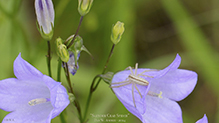 |
||
On one outing I came across Slender... It was just hanging out on a prairie flower at Frenchman’s Bluff SNA June 2024. I had no idea there was a Slender Crab Spider too. Compared to the other types it is a slender one. |
||
Mike Fellows |
||
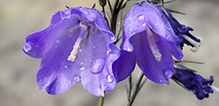 |
|
|
MinnesotaSeasons.com Photos |
||
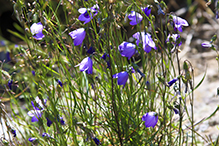 |
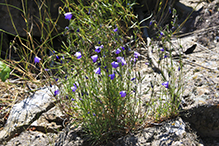 |
|
Plant |
||
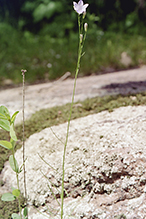 |
||
Plant |
||
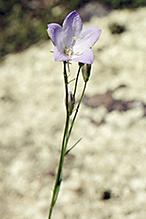 |
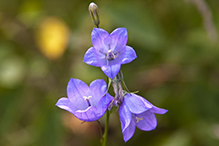 |
|
Inflorescence |
||

Slideshows |
|

Visitor Videos |
||
Share your video of this plant. |
||
This button not working for you? |
||
|
Other Videos |
||
Common Harebell (Campanula rotundifolia) |
About
Published on Jul 14, 2012 Common Harebell on Sunflower Hill in British Columbia. Common Harebell is native to temperate regions of Great Britain, Northern Europe, and North America. |
Harebell (Campanula rotundifolia) |
About
Uploaded on Jun 8, 2010 http://www.prairiemoon.com - Harebell also referred to as Bluebell Bellflower. It blooms at Prairie Moon Nursery in early June. |

Visitor Sightings |
||
Report a sighting of this plant. |
||
This button not working for you? |
||
Mike Fellows |
Location: Butterwort Cliffs SNA |
MinnesotaSeasons.com Sightings |
||

|
Created: Last Updated: © MinnesotaSeasons.com. All rights reserved. |
